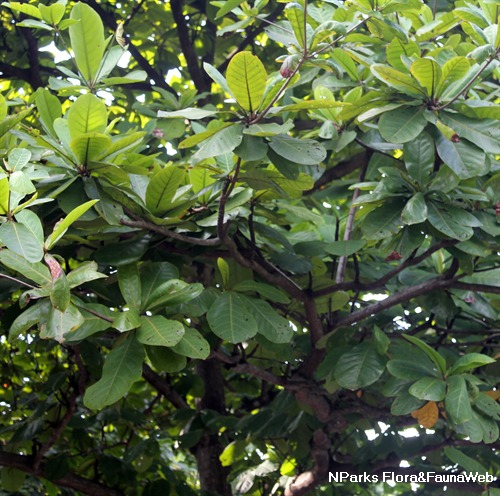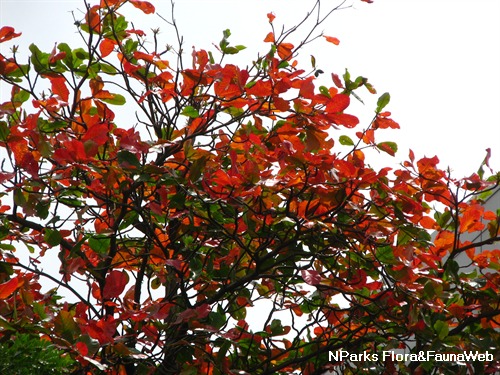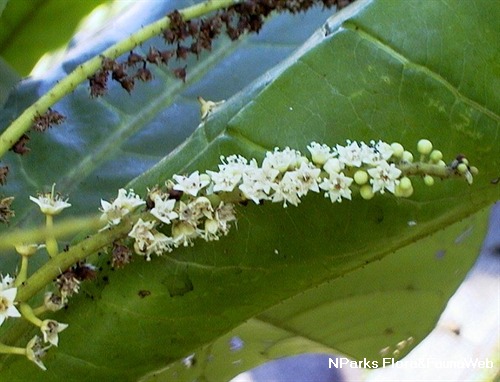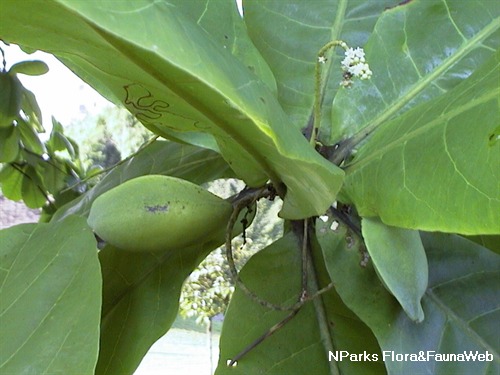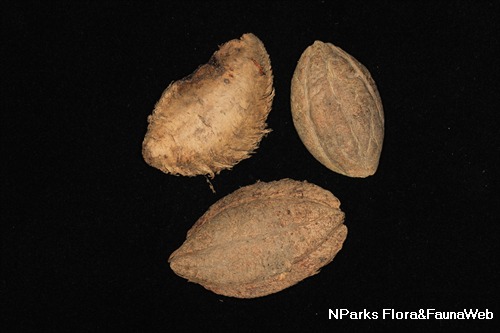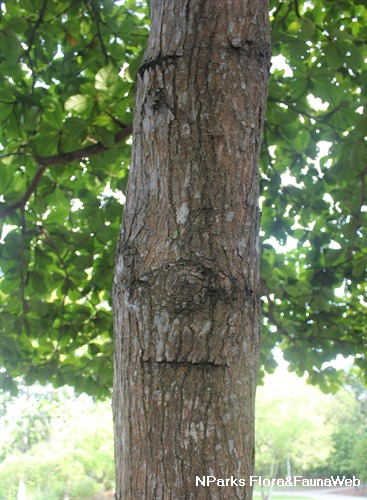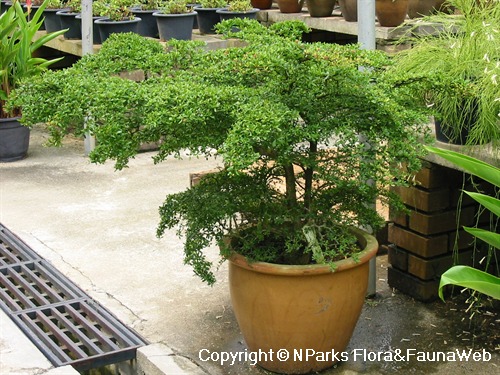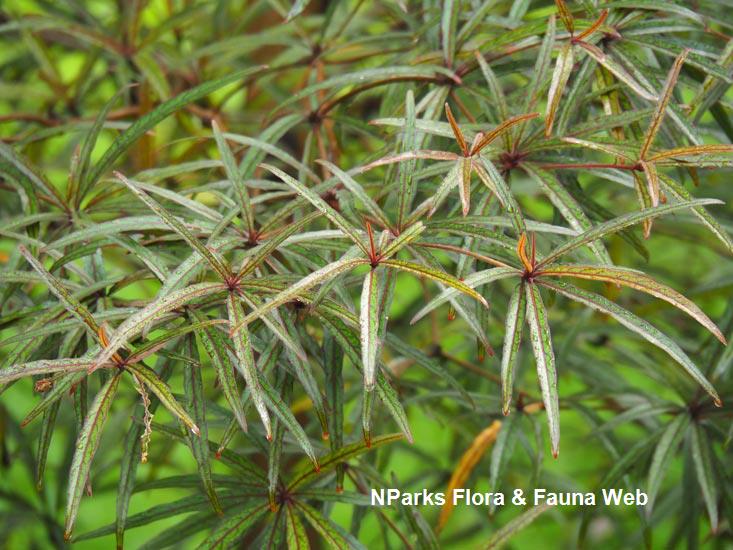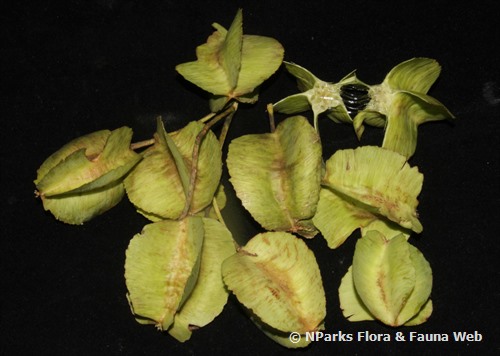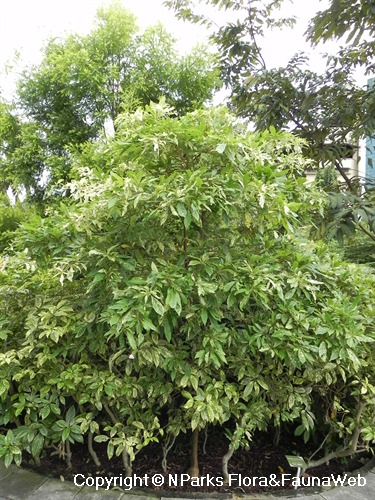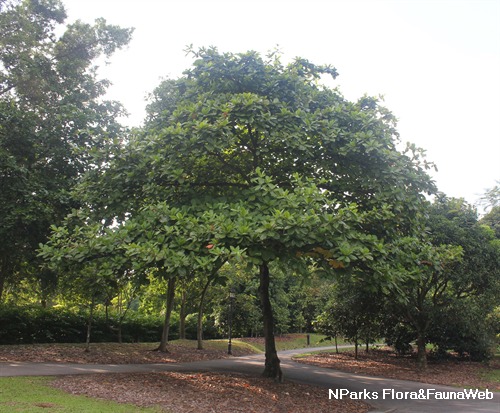
Back
Terminalia catappa L.
| Family Name: | Combretaceae |
| Synonyms: | Terminalia latifolia Blanco, Terminalia moluccana Lamk. |
| Common Name: | Sea Almond, Ketapang, Tropical Almond Tree, Pacific Almond, Singapore Almond, Indian Almond, Lingtak, Bastard Almond, Telisai, Jelawai Ketapang, 榄仁树 |
Name
Classifications and Characteristics
| Plant Division | Angiosperms (Flowering Seed Plants) (Dicotyledon) |
|---|---|
| Plant Growth Form | Tree (Big (>30m)) |
| Lifespan (in Singapore) | Perennial |
| Mode of Nutrition | Autotrophic |
| Plant Shape | Tiered |
| Maximum Height | 35 m |
| Maximum Plant Spread / Crown Width | 20 m |
Biogeography
| Native Distribution | From tropical Asia to North Australia and Polynesia |
|---|---|
| Native Habitat | Terrestrial (Coastal Forest), Shoreline (Mangrove Forest, Sandy Beach, Rocky Beach) |
| Preferred Climate Zone | Tropical, Sub-Tropical / Monsoonal |
| Local Conservation Status | Native to Singapore (Least Concern (LC)) |
Description and Ethnobotany
| Growth Form | It is a pagoda-shaped tree that can grow up to 35 m, and will shed its leaves twice a year. Its leaves are clustered at the end of the twigs. |
|---|---|
| Trunk | The trunk is often buttressed, with grey bark that is slightly fissured. |
| Foliage | It has spiral, stalked leaves that are papery to thinly leathery, dark green above, yellowish green below, and will turn red before falling. Each leaf is reverse-egg-shaped, 8–38 cm long by 5–19 cm wide, with 6–12 pairs of veins arising from the main vein of the leaf, and a pair of glands at the base of the leaf. |
| Flowers | The plant is monoecious, producing both male and bisexual flowers. The flowers are fragrant, white to whitish green, small, 0.5 cm across, and occur on numerous-flowered, 8–16 cm long flower shoots that are inserted at the leaf axils. |
| Fruit | It produces fruits with a stony core that are green when unripe, yellow or red when ripe, flattened-egg-shaped, 3.5–7 wide long by 2–5.5 cm wide. 2 narrow wings, up to 3 mm wide, can be found along the side of the fruit. Each fruit contains 1 seed. |
| Similar | Easily mistaken for Fagraea crenulata (Cabbage Tree), which has a similar shape and foliage, and is also a wayside tree. However, the Cabbage Tree is not deciduous and has larger, more obovate leaves, thorny branches, as well as deeply furrowed bark. |
| Associated Fauna | The fruits are attractive to bats which also help with seed dispersal. |
| Etymology | Terminalia, in Latin, refers to the plant’s leaves that are clustered at the end of end of the twigs, The name catappa is derived from its Malay name, ketapang. |
| Ethnobotanical Uses | Edible Plant Parts : Edible Fruits Food (Fruit or Vegetable): The kernel has a flavour similar to almonds, hence the common name. Cultural / Religious: Heritage Tree: There are currently 3 individuals of Terminalia catappa listed as Heritage Trees in Singapore. To find out more about this tree, please visit the Heritage Tree Register. Others: The leaves and bark are used in tanning and dyeing. |
Landscaping Features
| Landscaping | It is suitable as a roadside tree, as it is coastal plant, which can tolerate hot sun, dry and high wind condition. It is attractive as its plant shape is similar to a pagoda, and its leaves will turn red before falling. |
|---|---|
| Desirable Plant Features | Ornamental Foliage, Ornamental Form |
| Landscape Uses | Coastal, Suitable for Roadsides, General, Parks & Gardens, Beachfront / Shoreline |
Fauna, Pollination and Dispersal
| Fauna Pollination Dispersal Associated Fauna | Bat Food |
|---|---|
| Pollination Method(s) | Biotic (Fauna) |
| Seed or Spore Dispersal | Biotic (Fauna), Abiotic |
Plant Care and Propagation
| Light Preference | Semi-Shade, Full Sun |
|---|---|
| Water Preference | Moderate Water |
| Plant Growth Rate | Moderate |
| Rootzone Tolerance | Drought Tolerant, Moist Soils, Well-Drained Soils, Saline Soils / Salt Spray |
| Propagation Method | Seed |
Foliar
| Foliage Retention | Drought / Semi-Deciduous |
|---|---|
| Mature Foliage Colour(s) | Green |
| Mature Foliage Texture(s) | Papery, Leathery, Thin |
| Foliar Type | Simple / Unifoliate |
| Foliar Arrangement Along Stem | Spiral |
| Foliar Attachment to Stem | Petiolate |
| Foliar Shape(s) | Non-Palm Foliage (Obovate) |
| Foliar Venation | Pinnate / Net |
| Foliar Margin | Entire |
| Leaf Area Index (LAI) for Green Plot Ratio | 3.0 (Tree - Intermediate Canopy) |
Floral (Angiosperm)
| Flower & Plant Sexuality | Unisexual & Bisexual Flowers(Sub-dioecious) |
| Flower Colour(s) | White, Cream / Off-White |
|---|---|
| Flower Grouping | Cluster / Inflorescence |
| Flower Location | Terminal |
Image Repository
Others
| Master ID | 1888 |
|---|---|
| Species ID | 3181 |
| Flora Disclaimer | The information in this website has been compiled from reliable sources, such as reference works on medicinal plants. It is not a substitute for medical advice or treatment and NParks does not purport to provide any medical advice. Readers should always consult his/her physician before using or consuming a plant for medicinal purposes. |

